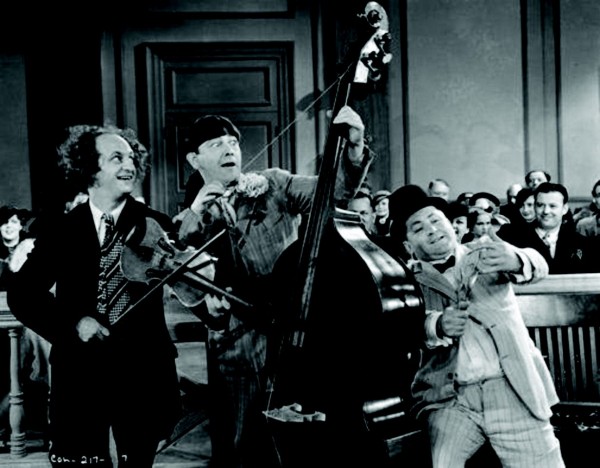
“Voulez Vous” by ABBA, “Windfall” by Son Volt, “Little Lion Man” by Mumford & Sons, “Sail” by AWOLNATION, “Love Song” by Sara Bareilles, “Girl” by The Beatles, “We Will Rock You” by Queen – is there anything these megahits have in common, other than fame?
Videos by American Songwriter
Say “Vou-lez Vous” slowly and you’ll hear it: the power of three-part sounds to charm the ears. All of these songs display this power in one or more of its many forms. Writers call it “The Rule Of Three” and employ it liberally in lists, jokes, slogans, and titles, such as “We like Ike,” “The Three Musketeers” or “Life of Pi.” Songwriters apply it to music, as well. “The Power of Three” reflects the exponentially expanded expressiveness of harmony, melody, and rhythm.
Check out the examples that follow, and the next time the Muse is acting coy, just ask her, “Voulez vous?” The results may surprise you.
Names and Titles
Band names with three syllables (“The Beatles”), three words (“The Beach Boys”), or one repeated word or sound (“Sha Na Na”) are punchy and memorable.
Also savor these song titles:
“9 To 5,” “Across The Universe,” “Achy Breaky Heart,” “All My Loving,” “Blue Suede Shoes,” “Breakaway,” “Come Sail Away,” “Dancing Queen,” “Don’t Be Cruel,” “Don’t Know Why,” “Get A Job,” “Gimme! Gimme! Gimme!,” “Here Without You,” “In My Life,” “Lady In Red,” “Lay Down Sally,” “Like A Virgin,” “Lookin’ For Love,” “Love Me Do,” “Magical Mystery Tour,” “Money, Money, Money,” “More Than Words,” “Mr. Tambourine Man,” “Paint It Black,” “Please Please Me,” “Shangri-La,” “S.O.S.,” “Sultans Of Swing,” “Sweet Home Alabama,” “Teach Your Children,” “Tears In Heaven,” “Ticket To Ride,” “Twist And Shout,” “Umbrella,” “Under The Boardwalk,” “Waterloo,” “What’s Going On,” “You Needed Me”
Beats
Some three-beat rhythms have proven remarkably durable, such as the “Boom, boom, BOP” of “We Will Rock You,” which lives on in gangsta rap. And let’s not forget the short-short-long of the foxtrot (“Enter Sandman,” “Cheek To Cheek”), or the “One, two, three” of the waltz.
Ornaments
A trio of notes on a single beat can pack an emotional wallop way out of proportion to its brevity. Modern melodies favor falling flourishes. Consider “Windfall” by Son Volt (“May the wind take your troubles away-ay-ay”), and “Glory Days” by Bruce Springsteen (“…after she put her kids to be-e-ed”) and “Wonderwall” by Oasis. The Beatles were early adopters with “Girl” (“Ah, Gi-i-rl”) and “A Hard Day’s Night” (“…working like a do-o-og”), among others.
Motives
Many songs are built around a three-note motive, such as ABBA’s “Vou-lez Vous” and “Does Your Mother Know” (“You’re so hot/ teas-ing me/ so you’re blue/ but I can’t/ take a chance/ on a chick/ like you”). Also see “Ma-ri-a,” “Yes-ter-day,” “Don’t Blame Me” (The Everly Brothers) and “I’ve Come To Expect It From You” (George Strait: “So up-set,” “Sit and smoke,” “Cry and joke”).
Repeating notes only mildly affect the feel: Check ABBA’s “Knowing Me, Knowing You” (on “No more carefree laughter” and “Knowing me, knowing you”), “Super Trouper” (on “Shining like the sun, Smiling having fun”), “Lay All Your Love On Me” (on “Lay all your love on me”), “Money, Money, Money” (on “Money, money, money/ must be funny/ in a rich man’s world”) and “Thank You For The Music” (on “Thank you for the music”). Also see “Michelle” (on “Mi-chelle, my belle”), “Daddy Sang Bass” (Carl Perkins), “Gentle On My Mind” (John Hartford) and “The Man I Love” (Gershwin).
Measures, Sections, and Phrases
When repeating longer time spans, composers avoid monotony by varying the material. These variations often create melodic rhymes that intensify meaning (see my May/June 2013 column). Sometimes the length of the final variation is doubled, as in “Dancing Queen” by ABBA: “You can dance” (1-measure pattern), “you can jive” (1 measure), “having the time of your life” (2-measure response). This uses the Power of Three to create a four-measure phrase.
Here’s more from The Beatles:
“Hello, Goodbye”: “You say yes” (3 notes, 1 measure), “I say no” (3 notes, 1 measure, melodic rhyme), “You say stop” (3 notes, 1 measure, melodic rhyme), “and I say/ go, go, go” (3 + 3 notes, 2 measures), “Oh, no” (3 notes, 2 measures). This adds up to a balanced but asymmetrical seven-measure phrase.
“Being For The Benefit Of Mr. Kite!”: “For the benefit of Mr. Kite” (3 tones, repeated notes, 1 measure), “there will be a show tonight” (3 tones, repeated notes, 1 measure, melodic rhyme), “on tram-po-line” (pattern breaks on the third go-round).
“Good Day Sunshine”: “Good Day Sun-shine” (2-measure pattern), “Good Day Sun-shine” (repeat), “Good Day Sun-shine” (pattern and key center varied on the third go-round).
Outro
Take one of your unfinished songs and apply the Power of Three to single notes, beats, measures, sections, or phrases. It may pull you through. Also check your favorite songs for Power-of-Three ideas. The examples given here barely scratch the surface.
Special thanks to my editor, Evan Schlansky, for suggesting the topic for this issue. Next time I get to Nashville, I’m buying – the first three rounds, naturally.













Leave a Reply
Only members can comment. Become a member. Already a member? Log in.